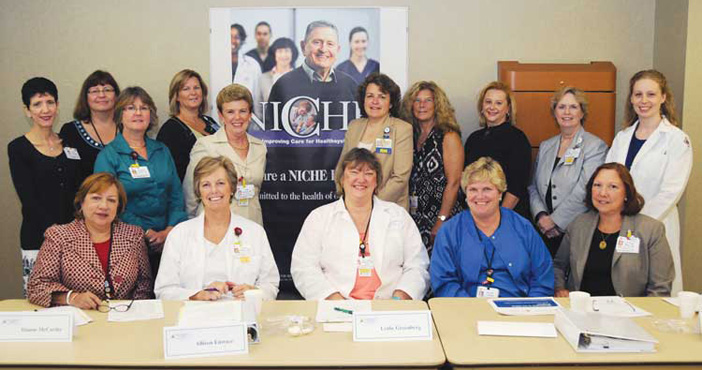Sibley and Suburban Hospitals Collaborate on NICHE Program
by Susan Middaugh
A red straw in a clear plastic cup. Telephones with large numbers. A splash of color in bathrooms and hallways to help patients differentiate one surface from another and to prevent falls.
“Simple additions like these can improve the inpatient hospital experience of adults age 65 and older,” says Denise Carlson, MBA, RN, who directs the adult medical unit at Suburban Hospital. On average, 70 percent of the patients in her unit are age 65 and older and 30-32 percent are 85 and older.
To provide better outcomes and patient-centered care for older adults,
Suburban and Sibley hospitals are collab-orating on a national multidisciplinary program called NICHE (Nurses Improving Care for Healthsystem Elders). NICHE was developed by the Hartford Institute at New York University College of Nursing and has since spread to 300 hospitals in 40 states and Canada.
The rationale for this partnership is that both hospitals in the Johns Hopkins system have similar demographics. They share a home health agency and the same goals. “Together we’re looking to develop and apply a consistent standard of care for these patients,” says Joan Vincent, MSN, MS, RN, senior vice president for patient care services and chief nursing officer for Sibley.
Both hospitals have achieved NICHE-designated status and assembled a leader-ship team committed to developing an expertise in geriatrics. Their long-term objectives are ambitious: to raise patient satisfaction and promote continuity of care between their hospitals and other community settings, and to reduce hospital-acquired conditions and complications that increase length of stay and inpatient costs.
There’s a lot at stake and more work to be done. “It will be a challenge to establish a baseline and measure cognitive and physiological functions for this population,” says Vincent. “Older adults have fewer physical and emotional reserves. They may be healthy when they enter the hospital, but it may only take one event for them to spiral downward.”
Staff awareness, especially at the bed-side, is critical, and Sibley and Suburban are emphasizing education. All nursing staff must be trained in the basics of providing care for older patients, and a cadre of older adult champions must be identified and created. Eventually, the goal is to have certified geriatric resource nurses as the go-to experts at each facility. But first someone has to evaluate what each nursing group needs in terms of course content and training. At Sibley that person is Edie Fowlkes, RN, who works in the Emergency Department. To answer those questions, Fowlkes, a member of the NICHE team, is taking NICHE training herself.
She can foresee situations where NICHE training could help. “The medication needs of an 85-year-old may be very different from a 55-year-old,” explains Fowlkes. “As patient advocates, nurses may be in a position to speak to the prescribing physician and recommend some adjustments.”
“This program has been a call to action for all of us,” says Barbara Jacobs, MSN, RN, Suburban’s senior director of nursing and chief nurse officer, describing one initiative in a pilot program at the
hospital. Patients on the adult medical unit there, including those with dementia, are now more active. “We have them playing cards and using exercise balls,” says Carlson. “One day, two of our male patients, ages 100 and 84, were singing in the hallway.” Keeping patients occupied during the day offers a double bonus: it has reduced the number of falls on the unit as well as patients’ social isolation.
To teach members of her staff what it’s like to be older, Carlson uses role play, storytelling, and props, such as eyeglasses that simulate a detached retina and ear plugs. “When one of my younger nurses put on the cataract glasses, her posture and her whole demeanor changed,” says Carlson. “She couldn’t identify the food in front of her and had trouble distinguishing medications.”
At Sibley, the NICHE training has also been a catalyst for change. “We’re building a new hospital and renovating the orthopedic floor in the current facility,” says Dianne McCarthy, MS, director of Sibley’s Center for Rehabilitation Medicine and an interdisciplinary member of its NICHE team. Plans for the new lobby had initially included a two-toned floor but the design posed a potential safety problem for older adults with impaired vision. As a result, the plan for the two-toned floor was discarded.
Both hospitals also recognize the positive impact that NICHE can have on recruitment and retention. “My nurses are taking greater pride in their work as a result of the NICHE training,” Carlson says. McCarthy agrees. “My staff is very excited about getting more training and working with nursing. Becoming a specialist is attractive to the whole team of physical, occupational, and speech therapists,” she adds.
Early next year, Sibley and Suburban plan to conduct a comprehensive survey called the Geriatric Institutional Assess-ment Profile. Susan Ohnmacht, MSN, MS, RN, Sibley’s associate chief nursing officer and director of critical care, says the 152-question survey will measure nurses’ attitudes, perceptions of the strengths and limitations of the hospital to provide care for older patients, and knowledge of institutional guidelines and best practices regarding issues such as pressure ulcers and sleep disturbances for older patients.
Based upon feedback from patients on Suburban’s medical unit, NICHE promises to be a success. “Admission into the hos-pital can be the worst time in people’s lives,” says Carlson. “Now, all I ever hear from patients is, ‘We feel like we’re family.’” One male patient demonstrated that recently by sending the staff 100 roses. “The nurses are happy too,” she adds.
